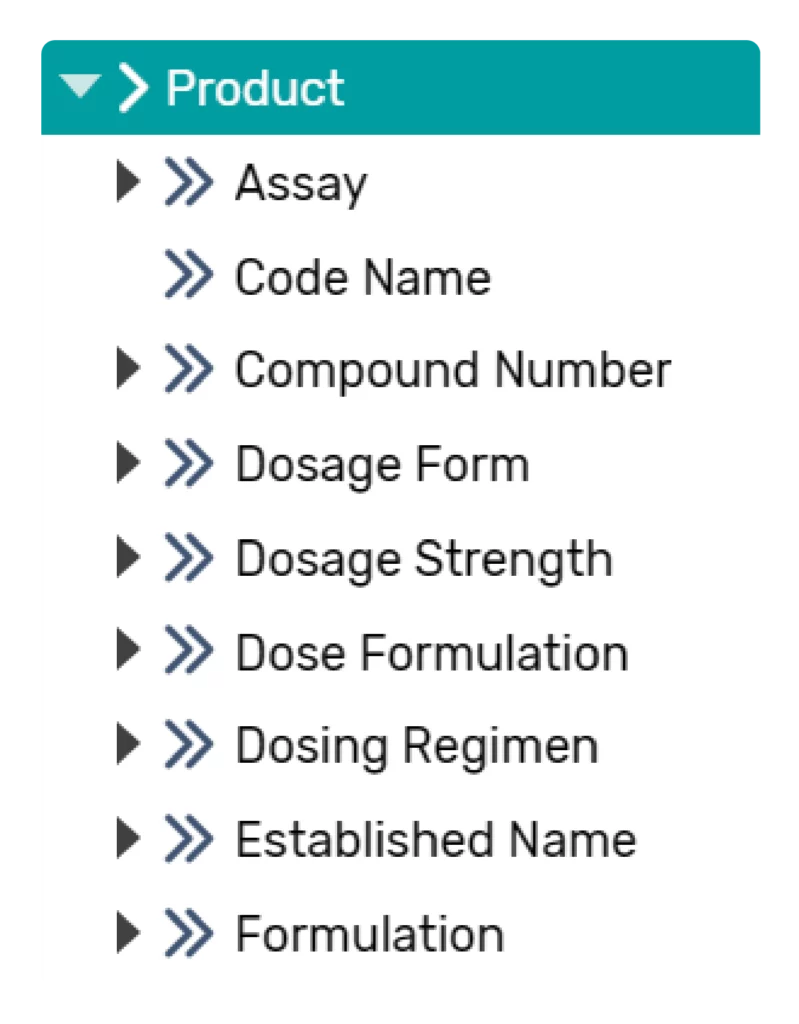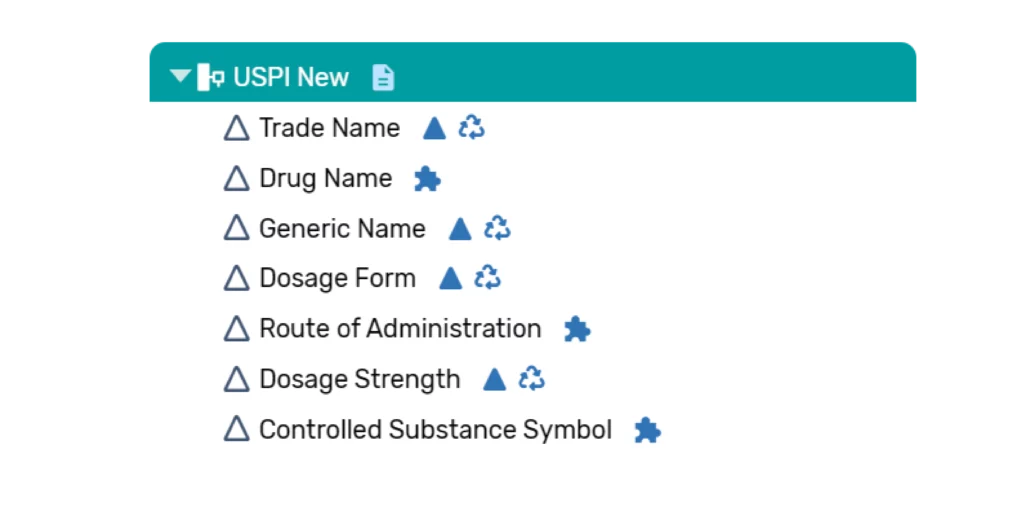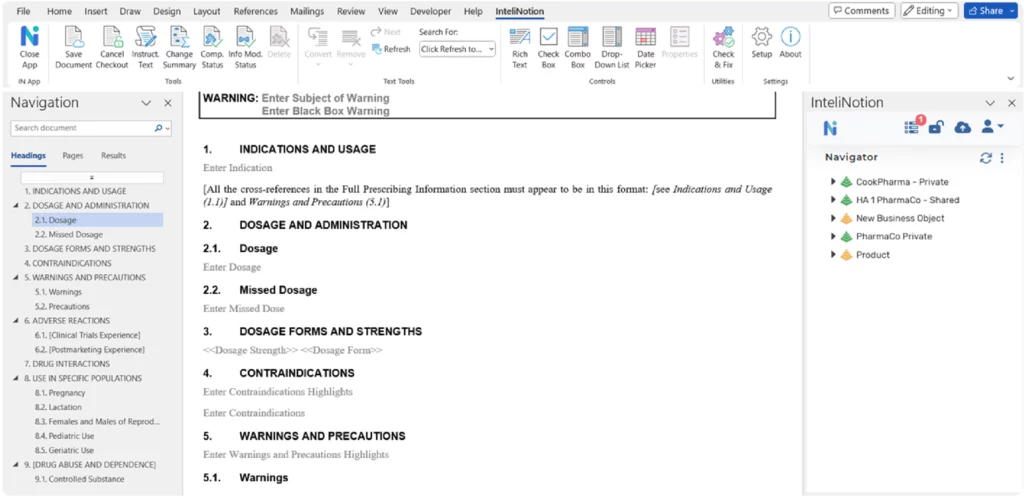Solution Brief
Features
Solutions And Delivery Approach For Labeling
As part of our structured content authoring (SCA) solution, we deliver a labeling module by leveraging the core platform capabilities. Preconfigured base models and templates are delivered for the USPI, SmPC, Annex II, Annex IIIB Blisters, Annex IIIB Intermediate, Annex IIIB PL, and the Canadian Product Monograph. Other templates that could be configured and delivered include client-specific country-specific package inserts and patient leaflets using either a Company Core Data Sheet (CCDS) or Reference Country documents as the base for auto-population.
Please refer to the Structured Content Authoring Solution Brief for general information concerning the patented InteliNotion platform and details concerning its specific available features.
Labeling Business Challenges
Labeling challenges described by our clients include:
- Copy/paste within and between documents with no traceability
- Reuse content to increase authoring efficiencies by using library content or metadata- driven auto-population of information
- Reuse CCDS to create county/region-specific labeling documents
- Reuse reference-country documents to create county/region-specific documents
- Independently update county/region-specific labeling documents without impacting upstream document(s)
- Assess change impact for document or content element by identifying and evaluating where content is reused and determine if a change to CCDS or reference-country documents are needed
- Provide a global view of labeling documents and submissions status
To help address these issues, as well as ensuring quality, consistency, and improved efficiencies, information can be structured within documents into meaningful content elements that can be reused within and across documents while being fully traced. This structuring of information also aids in making and tracking key decisions during the authoring, review, and approval phases. Structuring content also promotes easier to track component level lifecycles and publishing of appropriate content elements into required formats for downstream processes, systems, or applications.
Metadata Model Configurations
A baseline metadata catalogue will be supplied including product-level metadata elements that can be used for documents. The type and number of metadata are easily modified by the client to fit their needs. Configured metadata can be imported from an authoritative source system. Based on client-specific authoritative sources, integrations can be rapidly implemented within the platform. Examples of metadata that could be configured and used for labeling include:

Information Model Configurations
Labeling baseline information models are provided for Core Data Sheet, USPI, SmPC, Annex II, Annex IIIB Blisters, Annex IIIB Intermediate, Annex IIIB PL, and the Canadian Product Monograph. These models can be easily reconfigured by client to accommodate any company-specific modifications or additions to those documents. Other modifications that could be made include adjustments to the document granularity or level of detail provided in each content element. Information models for other labeling documents can be easily configured by the user using these models as examples. An example of a USPI that reuses information from a CCDS configuration is provided. The icons indicate whether the element is metadata or content and if it is reused from another model.

Template Configurations
Baseline labeling templates have been configured following FDA (for USPI), EMA (SmPC, Annex II, Annex IIIA, and Annex IIIB), and Canadian (product monograph) guidance documents. A generic CCDS has also been configured that could be modified to align with a company-specific document in not only structure but also standard text. Instructional text can be added for each content element to provide contextual information for authoring and reviewing that section as well as reference to guidance documents if desired. The templates are structured by inserting content elements defined by the business into the framework provided by the guidance documents. Multiple versions of any template can be stored if country- or region-specific versions are needed.

Document Generation & Authoring
Authorized users can easily generate labeling documents within the platform by simply selecting “Generate and Open Document” action and providing the labeling parameters (ie, labeling document type) for the document to be generated. When the document is generated, the system will automatically:
- Reuse content from one or more existing documents based on reuse policies configured in the information models; reuse policies determine if content is reused “as-is” (no editing allowed) or repurposed (editing allowed in the new “branch” of the source component)
- For example, a CCDS can be used to generate country-specific package inserts (eg, USPI and SmPC) or country- or region-specific documents could be generated from a designate reference-country package insert
- Auto-populate content from content libraries based on configured rules; rules are prespecified within the information model and are executed based on user-selected metadata at the time of document generation
- For example, if the user selects a specific country, the labeling documents could be auto populated with exact language for that country or region.
- Prepopulate variables (i.e. metadata values) based on template configurations.
- Author by inserting library content, by navigating to other documents for known content, by searching related content associated with that content element, or by typing new content.
Regardless of how content is populated (reuse, auto-population, de novo), traceability of all components is maintained is maintained, can be governed, and can be evaluated by using several reporting options.
Value Delivered
The InteliNotion platform facilitates an easy to configure approach that enables structured authoring for labeling documents. Information consistency between documents can be achieved by leveraging the use of library content, information auto-population, and/or metadata that are governed by pre-established reuse policies. Documents can also reuse information from user-defined “base documents” that can be inherited “as is” or with the ability to update the content. Throughout document authoring, traceability of the information is maintained. This traceability simplifies change impact assessment and identification of documents that may need to be updated due to Health Authority questions or later in the product lifecycle. The notification system can be used to inform the organization of changes to documents, the potential need for updates, or any lifecycle change. All these functions can be defined with a lifecycle that is managed by the business for their unique needs. For day-to-day activities, most features are provided in an App that allows users to work in the familiar Microsoft Word program with all its functions. Updating and maintaining the models and templates is intuitive and can be done by the business. Our team will provide training and business enablement.